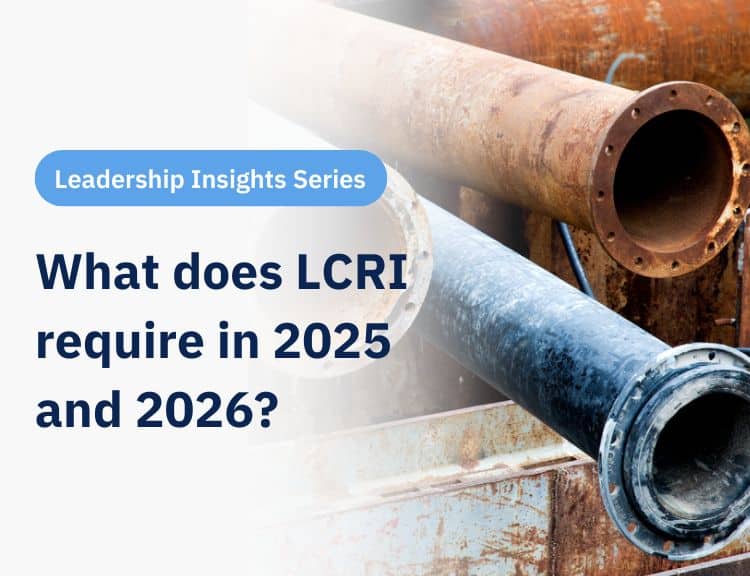With initial service line inventories complete or nearly complete, water systems with lead and GRR are turning their attention to replacement planning.
The upcoming LCRI guidance is expected to outline timeline and requirements for replacement planning (among other requirements). It is also expected to include a deadline for the submission of an initial replacement plan, a document that outlines the water system’s strategy and tactics for prioritizing and executing lead line replacements.
Creating an efficient, defensible replacement plan can seem like a daunting task. So where to begin?
With data, of course.
Understanding the key data sets that can influence replacement need, risk, and efficiency will help you better understand your current lead landscape and make strategic decisions about where, how, and when to focus your replacement efforts. (more on strategic questions to ask when developing a replacement plan in a forthcoming blog post.)
So, what data should you consider when beginning to think about replacement planning? Here are six key data sets to get you started.
1. Service Line Inventory
The purpose of a service line inventory is to aggregate all of your existing data on lead line locations (and other service line materials) in order to drive replacement planning. Your service line inventory helps you understand your overall volume of lead/GRR; understanding the total number of replacements needed can help you budget and plan.
Your service line inventory also helps you understand the actual locations of your lead service lines, which is critical data as you plan where you need to go for replacement work.
2. Lead likelihood predictions
For the ~75% of water systems that still have outstanding unknowns, your service line inventory data is incomplete. Outstanding unknowns are likely obscuring your understanding of the exact volume and location of all the lead/GRR service lines in your system.
Managing unknowns is not only a compliance requirement; it is a core data need to ensure you have a clear view of what, exactly, you need to plan for. For those water systems with unknowns, www.LeadOutMap.org can give you a sense of your likely volume of LSLs systemwide.
Service line-level lead likelihood prediction data helps fill in the gaps about volume and location of lead/GRR service lines in your system, which helps you get ahead of compliance requirements and make more accurate data-driven decisions regarding replacements, budget needs, public communication, and more. In nearly every state, predictions can also be used to classify service lines as Lead or Non-Lead, which reduces your inventory compliance burden related to unknown management.
3. Presence of children and other vulnerable populations
The reason we are all spending so much time and attention on lead service line identification and replacement is that there is no safe level of lead in drinking water and young children are particularly vulnerable to lead poisoning.
Understanding where children and other vulnerable populations may be drinking water from a lead service line can help prioritize your LSLs with the highest public health risk.
4. Socioeconomic and environmental justice demographics
Research also shows that historically underserved communities and low income households suffer the most from lead poisoning. Datasets showing your water system’s demographic makeup can help you assess public health risk and prioritize areas in most urgent need of LSL replacements.
The EPA’s approach to LSL replacement also prioritizes historically underserved communities, with multiple funding resources available specifically for this work. So paying attention to environmental justice data as you prioritize LSL replacements isn’t just the right thing to do, it also pays (literally) to prioritize these replacements.
5. Streets, neighborhoods, and other geographic boundaries
LSL replacement is a big project and it doesn’t make sense to dig 1 service line at a time. So while your inventory data shows LSL status line-by-line, your replacement plan will need to consider other geographical boundaries, such as street, neighborhood, political district, and more.
The ability to overlay geographical boundary data with LSL status can help you strategize and prioritize in planning. Whether you want to identify the highest risk blocks or neighborhoods or ensure an equitable approach to replacements across all political districts, geographical data is a key ingredient as you translate your service line inventory data into an actionable plan.
6. Budget
Budget data is a little bit of a chicken & an egg puzzle when it comes to LSL replacement; having a replacement plan can help you access funding, but you must also consider funding realities when making a realistic, short-term plan to begin LSL replacements.
Understanding the types of funding, and actual amounts, available for LSL replacement can also help you prioritize LSL replacement projects and consider how replacement projects fit into the broader ecosystem of water infrastructure projects in your community. And speaking of related projects…
7. Overlap with past & ongoing projects
This is likely a mix of quantitative and qualitative data, but deciding how you want LSL replacements to fit into your other infrastructure work is critical. For example, we recently had a customer tell us that they had just completed a big sewer replacement project and they wanted to avoid replacements on these streets so they wouldn’t be ripping up streets that had just recently been repaved.
On the flip side, there is DWSRF funding available for complete LSL replacements that take place as part of broader capital improvement projects; in this case, intentionally aligning replacement work with existing projects might be an efficient way to maximize your replacement progress & funding.
Efficient, effective replacement planning relies on a lot of data and thinking strategically about how to put these data points together to build a replacement plan that best meets your community’s needs.
If you’re curious to learn more about data-driven replacement planning, and how BlueConduit can help, sign up to be the first to hear about new BlueConduit replacement planning products & resources.





